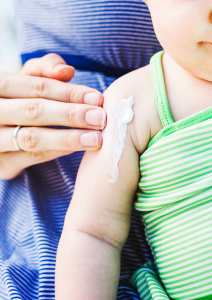No products in the cart.

As parents, ensuring the health and safety of our children is a top priority, especially when it comes to protecting their delicate skin from the harsh effects of the sun. Sunscreen is a crucial tool in our arsenal against sunburn, skin damage, and long-term risks like skin cancer. But with the myriad of options available, selecting the right sunscreen for kids can feel overwhelming. In this guide, we’ll explore key factors to consider when choosing a sunscreen for children, helping you make informed decisions for those sunny days ahead.
 Understanding the Sun’s Rays
Understanding the Sun’s Rays
Before diving into sunscreen specifics, it’s important to understand what we’re protecting our kids from. The sun emits two types of harmful rays:
- UVA Rays: These penetrate deep into the skin, leading to aging and long-term skin damage.
- UVB Rays: These are primarily responsible for sunburn and play a significant role in developing skin cancer.
A broad-spectrum sunscreen offers protection against both UVA and UVB rays, a crucial feature for any sunscreen you choose for your child.
SPF: What Number is Enough?
Sun Protection Factor (SPF) measures how well a sunscreen can protect skin from UVB rays. For kids, dermatologists often recommend using a sunscreen with at least SPF 30, which blocks about 97% of UVB rays. Higher SPFs block slightly more UVB rays, but no sunscreen can block 100%.
Physical vs. Chemical Sunscreens: Which is Best for Kids?
Sunscreens are generally categorized into two types: physical (mineral) and chemical.
– Physical Sunscreens: These contain active mineral ingredients, such as zinc oxide or titanium dioxide. They sit on top of the skin and deflect the sun’s rays. They’re less likely to cause skin irritation, making them a preferred choice for children’s sensitive skin.
– Chemical Sunscreens: These absorb UV rays and then dissipate them as heat. They often contain a combination of ingredients and while effective, some of these ingredients may cause skin irritation or allergic reactions in kids.
Water Resistance: A Must for Active Kids
Children rarely sit still, especially when they’re playing in the water or sweating. Look for water-resistant sunscreens, which retain their SPF after a certain amount of time in the water. Remember, “water-resistant” does not mean “waterproof”; reapplication is still necessary.
Ease of Application: Lotions, Sprays, or Sticks?
-Lotions: provide a thick and even coverage but may require a bit more effort to apply thoroughly. Using a makeup brush can be helpful!
– Sprays are convenient, especially for squirmy kids, but it’s essential to avoid inhaling the product and to ensure proper coverage.
– Sticks: are great for targeted application, like on the face or around the edges of swimwear.
Tips for Application and Reapplication
– Apply sunscreen generously 30 minutes before going outdoors.
– Reapply every two hours, or immediately after swimming, sweating, or towel drying.
– Don’t forget about ears, noses, lips, and the tops of feet.
Sunscreen and insect repellent
Whilst convenient, products containing a combination of sunscreen and insect repellent are not recommended. Studies have found that the ability to filter out UV rays is reduced when combined with ingredients used in insect repellants. They also need to be reapplied at different intervals. It is safest to use separate products. And always apply sunscreen and then repellent.
Sensitive Skin
If your child has eczema or sensitive skin, look for sunscreens labeled as suitable for sensitive skin, usually free from fragrances, parabens, and other irritants.
Remember the Shade and Protective Clothing
Sunscreen is just one part of sun protection. Encourage playing in the shade, wearing hats, sunglasses, and UV-protective clothing to provide comprehensive protection.
Choosing the right sunscreen for your child doesn’t have to be daunting. Look for broad-spectrum coverage, an SPF of at least 30, water resistance, and formulations suitable for sensitive skin. Remember to apply it properly and combine it with other sun protection methods. Enjoy making those sunny day adventures both fun and safe.

 Understanding the Sun’s Rays
Understanding the Sun’s Rays